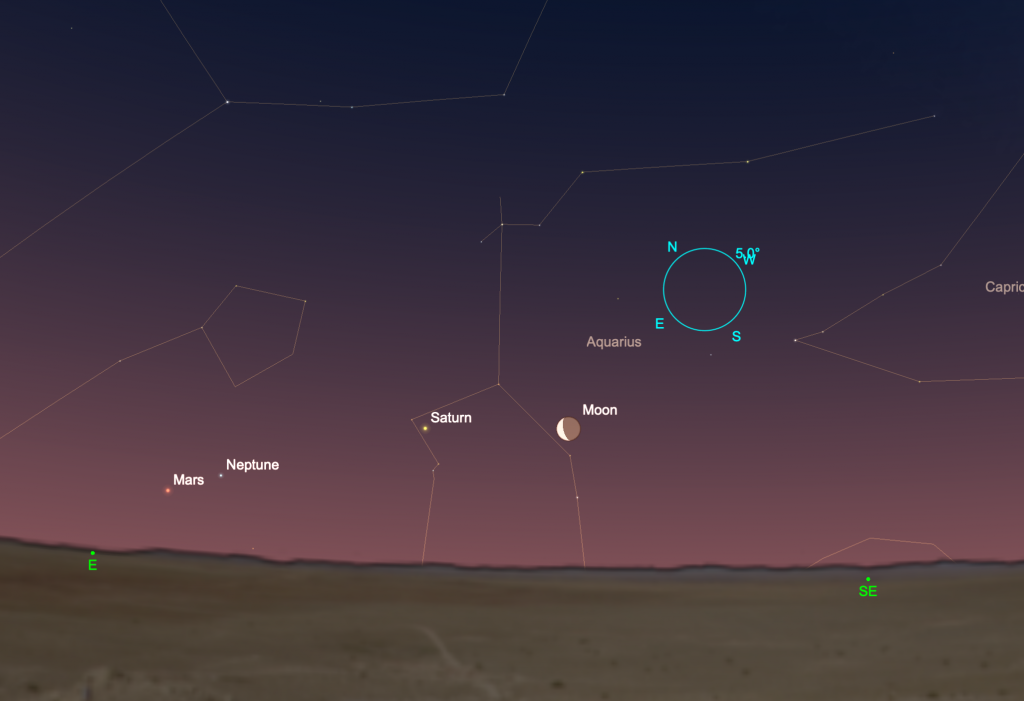
For deep-sky observers, May means galaxy season as our night sky looks out of the plane of the Milky Way into the intergalactic void. It’s the best time of year to grab some aperture and go deep. Those who rise early and look southeastward, however, see the bright band of the Milky Way rising along with Mars and Saturn. Venus and Jupiter lie too close to the Sun this month to observe. But the best meteor shower of the year for southern observers, the Eta Aquariids, is already going strong and peaks on May 5-6 with the Moon mostly out of the way. Here’s what to see in the night sky this month.
1 May 2024. Last Quarter Moon, 11:27 UT

3 May. Look to the southeast in the early-morning sky to see a waning crescent Moon, Saturn, and Mars lined up before dawn. Saturn has brightened to magnitude +1.2 and spans about 17”. Mars, at magnitude +1.1, outshines Saturn ever so slightly but spans a paltry 5”. Both grow only slightly larger and brighter throughout the month.
5 May. Mars and a thin lunar crescent lie less than 5o apart in the eastern sky before sunrise.
5-6 May. The usually reliable Eta Aquarid meteor shower peaks. The shower runs from April 21 through May 20 each year, with many meteors still visible for several days on either side of the peak. The Eta Aquarids occur as Earth passes through a stream of icy and dusty debris from Comet 1/P Halley, more commonly called Halley’s Comet. We pass through a second stream of the comet in late October during the Orionids meteor shower. Look for the meteors anywhere in the sky, preferably after midnight. They trace their paths back to a point near the star Eta Aquarii which rises in the eastern/southeastern sky before dawn. This is perhaps the best meteor shower of the year for southern hemisphere stargazers, but northern observers may see a few of these meteors too. NOTE: If you’re clouded out, you can always watch some of the shower on the excellent live feed from the Subaru Telescope on Mauna Kea, Hawaii.
8 May. New Moon, 03:22 UT

9 May. Mercury reaches its greatest western elongation about 26o from the Sun. The planet lies in Pisces and continues to brighten in the morning sky as it moves closer to the Sun over the next couple of weeks. Viewing strongly favors southern-hemisphere observers during this apparition; northern observers struggle to see the planet low over the eastern horizon this month.
15 May. First Quarter Moon, 11:48 UT
15 May. Look for the first-quarter Moon about 3o from Regulus, the brightest star in Leo, an anchor constellation in the northern spring sky.
18 May. Jupiter reaches conjunction with the Sun. It will reappear in the morning twilight in the east in the coming weeks.
19 May. A fattening gibbous Moon lies west of blue-white Spica in the eastern sky as darkness falls. The two are about 4o apart. If you’re up stargazing for a few hours, watch the Moon grow closer to the star as the night wears on. On May 20, the Moon sits about 6o east of the star.
23 May. Full Moon, 13:53 UT (The ‘Flower Moon’)

23 May. As you take in the Flower Moon rising in the east, look for brilliant Antares less than a degree north. Observers in the southeastern U.S., the Caribbean, Central America, and northeastern South America (including Brazil) will see the Moon occult the star. See timing for hundreds of locations along the path of the occultation at this link.
31 May. Last Quarter Moon, 17:13 UT
31 May. The quarter Moon lies about a degree south of Saturn low in the eastern morning twilight. Look for Mars further east and lower over the horizon.